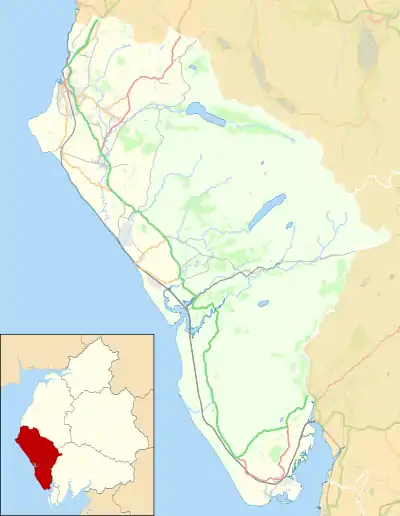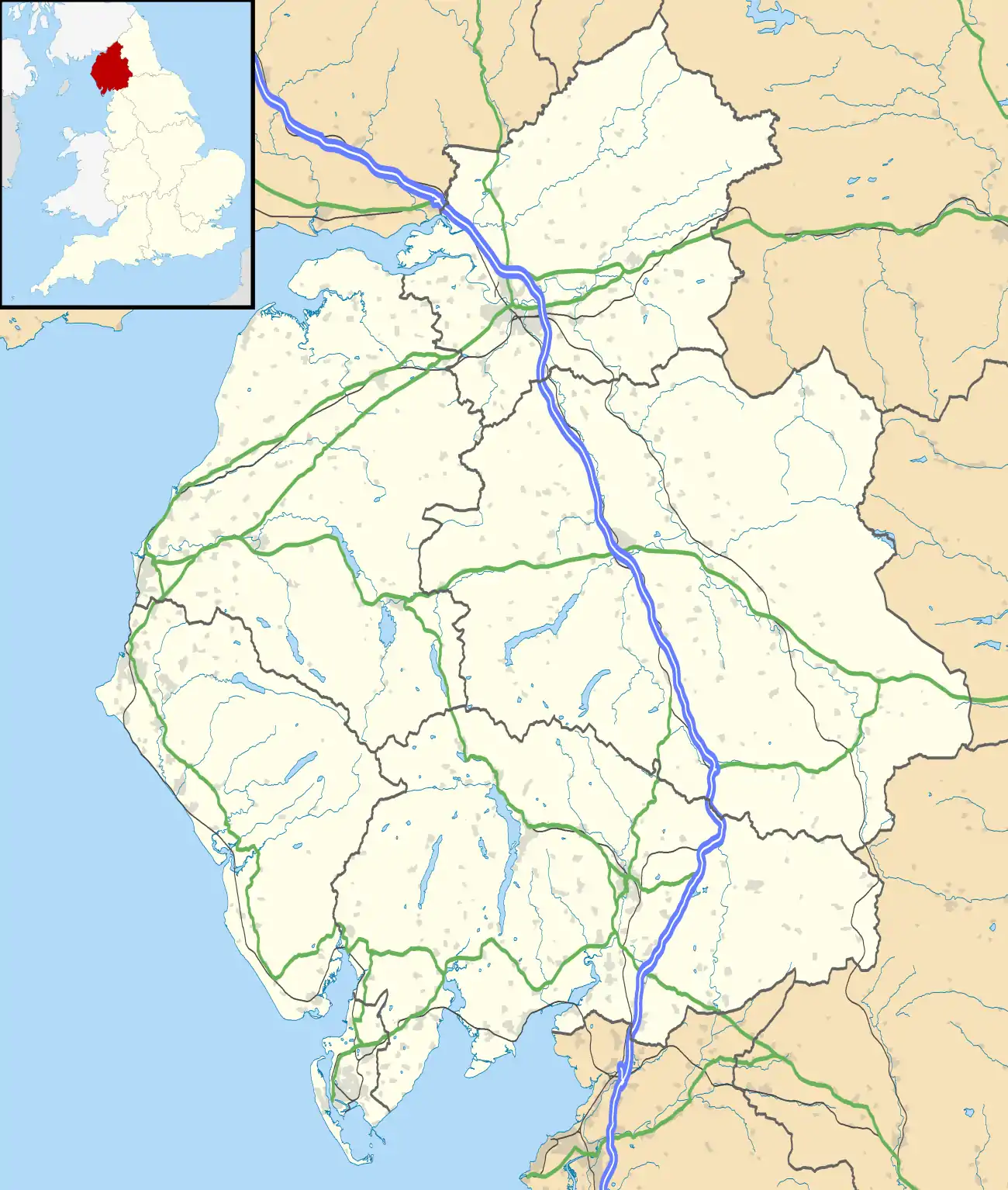Woodhouse Colliery
Woodhouse Colliery is a proposed coal mine near to Whitehaven in Cumbria, England. The proposal is for the first deep coal mine in England since Asfordby pit in 1987. The coal mine has been advertised as bringing jobs to a deprived area but has also come in for criticism by green campaigners. In 2019, Cumbria County Council granted the planning permission for the venture.
| Location | |
|---|---|
 Woodhouse Colliery Location in Copeland Borough  Woodhouse Colliery Location in Cumbria | |
| Location | Whitehaven |
| County | Cumbria |
| Country | England |
| Coordinates | 54°31′31.8″N 3°35′49.7″W |
| Production | |
| Products | Coal |
| Production | 3,000,000 tonnes (3,300,000 tons) projected per annum |
| History | |
| Opened | 2020 (projected) Full production expected in 2023 |
| Owner | |
| Company | West Cumbria Mining (WCM) |
| Website | Official website |
It is not to be confused with the former Woodhouse Close Colliery in Bishop Auckland, County Durham, which operated between 1835 and 1934.[1]
History
In June 2014, West Cumbria Mining announced its intention to invest £14.7 million in a venture to explore for premium quality coking coal underneath the sea off Whitehaven.[2] The project had started before as a plan to find and gasify the coal for energy use, but when the quality of the coal was discovered, it precipitated a shift into mining the coal for steelmaking. It is intended to use the coal only for coking rather than for the electricity supply industry (ESI). The fall in the price of ESI coal in the world markets also precipitated the closure of mines using coal only for ESI.[note 1][3][4] If approved, the mine would be Englands' first deep coal mine since the Asfordby pit was sunk in 1987.[5]
The inferred resources suggest that the mine could produce over 3,000,000 tonnes (3,300,000 tons) of coal per year from across a 77-square-mile (200 km2) section underneath the Irish Sea.[6] Backers of the scheme point out that Britain imports 6,000,000 tonnes (6,600,000 tons) of coke per year, of which none is sourced in Europe, with most being from Australia and the USA.[7][note 2][8]
The mine would use former but extant tunnels from previous mining ventures for coal and anhydrite.[9] The mine head would be located on the former Marchon chemical works site close to Haig Colliery and the suburb of Woodhouse just south of Whitehaven town centre in Cumbria.[10][note 3][11][12] The proposal would be to mine the carboniferous coal seam up to a maximum depth of 1,804 feet (550 m).[13]
In 2017, a geological team were working offshore from St Bees Head drilling into the rock 82 feet (25 m) below the sea bed to a depth of 2,000 feet (600 m). This will determine the quality of the coal and check for any geological conditions that could affect the planning of the mine.[14]
The mine is expected to have a life of 50 years and employ 500 workers with the possibility the area contains over 750,000,000 tonnes (830,000,000 tons) of coal in its reserves.[15] 80% of the output from the mine has been promised to be railed out of the area to Redcar Bulk Terminal on Teesside for export.[7] A conveyor would move the coal from the site to a loader 2 miles (2.5 km) away.[16] Trains would number up to six per day including Saturdays, though the company acknowledge that the increase in traffic on the railway would require signalling improvements on the Cumbrian Coast Line.[5] Additionally, West Cumbria Mining have applied to install a solar farm on the estate that would cover 600 acres (240 ha) and provide 40% of the electricity needs of the mining operation.[17]
West Cumbria Mining is owned by EMR Capital, a company based in Australia that has injected over £20 million into the venture by June 2017. A further £200 million was projected to be spent in final testing, acquisition of rights and the implementation of the mine.[5] The facility itself is expected to cost in the region of £165 million.[18]
The prospect of England's first new coal mine in over 30 years has prompted anger in parts of the local community with an action group (38 Degrees) starting up with the slogan Keep Cumbrian coal in the hole.[11] The protesters have pointed out that the underground workings would extend to within 5 miles (8 km) of the nuclear ponds at Sellafield and they also cite the proximity of the mine to a proposed new nuclear facility at Moorside.[19] Another concern is that of the prevalence of methane in the Cumbrian Coalfield. The protest group have pointed out that the dangerous levels of gas made the region an ideal test-bed for the Davy Lamp in 1816.[11][20][note 4][21]
Approvals and appeals
In March 2019, a meeting of Cumbria County Council's planning committee voted unanimously in favour of the project citing "the desperate need for jobs, particularly in deprived wards close to the proposed new mine". Green campaigners announced that they would launch a legal challenge. A spokesperson for South Lakes Action on Climate Change, said that the mine would "totally undermine Cumbria's chances of hitting emission targets".[22]
In November 2019, the government decided not to intervene in the appeals process and stated the "...[Cumbria County] Council should take the decision". Work on the site is expected to start in 2020, with coaling operations starting in 2022.[23]
Notes
- Such as Kellingley in West Yorkshire, the last deep coal mine in operation in Britain which closed after a drop in the world coal price.
- This was before the SSI UK steelworks at Redcar closed in 2015, imports of coke have dropped in line with demand with supply from Canada stopping completely in 2015.
- The Guardian article states that the proposed mine site is south of Kendal, but this is incorrect. A letter the following week by Marianne Kirkby amends this error.
- A 2004 British Geological Survey report details the known gaseous nature of the mines around Whitehaven and stated that the coal was not worthwhile mining for due to the methane and geological instability in the region. The boreholes that this data was taken from were drilled to a depth of 1,300 feet (400 m) but were all undertaken on land, not on reserves under the sea.
References
- "Durham Mining Museum - Woodhouse Close Colliery". www.dmm.org.uk. Retrieved 11 July 2018.
- "Plans to restore mining industry". BBC News. 10 June 2014. Retrieved 11 July 2018.
- Lodge, Tony (28 October 2016). "Tony Lodge: Old King Coal is dead, but long live British mining". The Yorkshire Post. Retrieved 16 July 2018.
- Bounds, Andrew (11 December 2015). "Date set for closure of UK's last deep mine at Kellingley". Financial Times. Retrieved 17 July 2018.
- Bounds, Andy (19 June 2017). "Global demand for coking coal set to revive Cumbria mining". Financial Times. Retrieved 11 July 2018.
- Samuel, Juliet (24 May 2013). "Vast coal discovery off Cumbria coast 'could fire up British mining industry'". The Times. p. 57. ISSN 0140-0460.
- Leroux, Marcus (17 November 2014). "Old King Coal makes a comeback in north west". The Times. ProQuest 1625304150.
- "UK coking coal imports by country 2002-2017 | Statistics". statista.com. Retrieved 13 July 2018.
- Lempriere, Molly (23 January 2018). "Mining the UK - Mining Technology". mining-technology.com. Retrieved 16 July 2018.
- Vaughan, Adam (23 March 2018). "Minister cites climate change in rejection of opencast coal mine". The Guardian. Retrieved 11 July 2018.
- Birkby, Marianne (28 March 2018). "Cumbrian coal must stay in the ground where it belongs | Letters". The Guardian. Retrieved 11 July 2018.
- "303" (Map). Whitehaven & Workington. 1:25,000. Explorer. Ordnance Survey. 2015. ISBN 9780319245552.
- "Hydrological and Hydrogeological Support for Proposed Metallurgical Coal Mine - ESI Consulting". esi-consulting.co.uk. Retrieved 16 July 2018.
- "Plans on display for West Cumbria coking coal mine". Whitehaven News. 23 June 2017. Retrieved 11 July 2018.
- Abbott, Jez (20 June 2017). "Planners probe metallurgical coal | Mineral and Waste Planning". www.mineralandwasteplanning.co.uk. Retrieved 16 July 2018.
- Jones, Ben (March 2018). "Coal traffic for Cumbrian coast?". The Railway Magazine. Vol. 164 no. 1, 404. Horncastle: Mortons Media. p. 78. ISSN 0033-8923.
- "2019 start proposed for work on £165m undersea mine off West Cumbria coast". News and Star. 23 April 2018. Retrieved 16 July 2018.
- Lea, Robert (20 March 2019). "First deep coal mine since 1980s approved". The Times (72, 799). p. 40. ISSN 0140-0460.
- "Protesters march in the rain against St Bees coal mine plans". North West Evening Mail. 11 September 2017. Retrieved 11 July 2018.
- "Untitled". Cumberland Pacquet and Ware's Whitehaven Advertiser. 9 April 1816. p. 3. OCLC 18699629.
- Jones, NS; Holloway, S; Creedy, DP; Garner, K; Smith, NJP; Browne, MAE; Durucan, S (2004). "UK Coal Resource for New Exploitation Technologies Final Report" (PDF). Nora.nerc.ac.uk. British Geological Society. pp. 103–104. Retrieved 16 July 2018.
- "Whitehaven deep coal mine plan moves step closer". BBC News. 19 March 2019. Retrieved 19 March 2019.
- "First UK deep coal mine in decades to go ahead". BBC News. 2 November 2019. Retrieved 7 November 2019.
Sources
- Woodhouse Colliery Planning Application Environmental Statement Non-Technical Summary (PDF) (Report). Whitehaven: West Cumbria Mining. 2017.